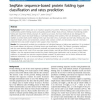BMCBI
2010
13 years 11 months ago
2010
Background: Biological processes in cells are carried out by means of protein-protein interactions. Determining whether a pair of proteins interacts by wet-lab experiments is reso...
BMCBI
2010
13 years 11 months ago
2010
BMCBI
2010
13 years 11 months ago
2010
Background: The large amount of high-throughput genomic data has facilitated the discovery of the regulatory relationships between transcription factors and their target genes. Wh...
BMCBI
2010
13 years 11 months ago
2010
Background: Biological networks offer us a new way to investigate the interactions among different components and address the biological system as a whole. In this paper, a revers...
BMCBI
2010
13 years 11 months ago
2010
Background: About 30% of genes code for membrane proteins, which are involved in a wide variety of crucial biological functions. Despite their importance, experimentally determine...
BMCBI
2010
13 years 11 months ago
2010
Background: MHC/HLA class II molecules are important components of the immune system and play a critical role in processes such as phagocytosis. Understanding peptide recognition ...
BMCBI
2010
13 years 11 months ago
2010
Background: Protein folding rate is an important property of a protein. Predicting protein folding rate is useful for understanding protein folding process and guiding protein des...
BMCBI
2010
13 years 11 months ago
2010
Background: Complex human diseases are often caused by multiple mutations, each of which contributes only a minor effect to the disease phenotype. To study the basis for these com...
BMCBI
2010
13 years 11 months ago
2010
Background: Several diseases, many of which nowadays pandemic, consist of multifactorial pathologies. Paradigmatic examples come from the immune response to pathogens, in which ca...
BMCBI
2010
13 years 11 months ago
2010
Background: Prediction of protein structural classes (a, b, a + b and a/b) from amino acid sequences is of great importance, as it is beneficial to study protein function, regulat...




